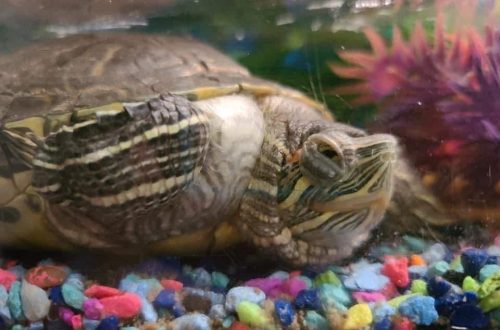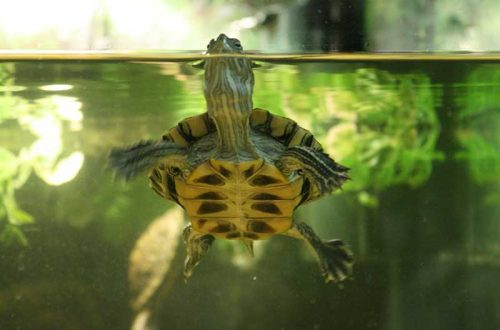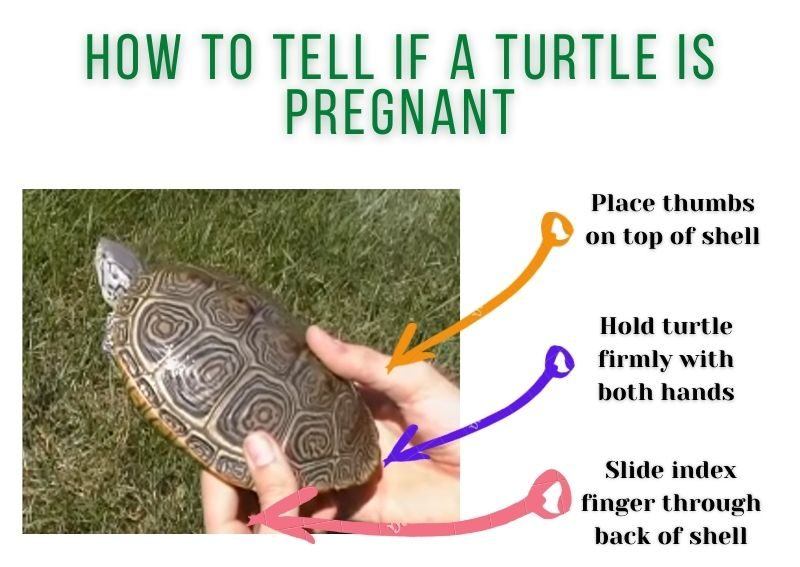
Red-eared turtle eggs, how to determine pregnancy and what to do if the turtle laid an egg
The simultaneous maintenance of heterosexual individuals of red-eared turtles at home, provided that optimal conditions are created, can result in pregnancy and childbirth of a female.
A small decorative turtle gives birth to several eggs and this stops her concern for offspring. Reptile lovers create ideal conditions for animals to mate, care for the expectant mother and her eggs, from which adorable tiny babies of bright green color subsequently appear. For successful offspring, you need to know how long the pregnancy lasts, how red-eared turtles give birth, and what to do if the reptile has laid eggs.
Contents
At what age can pregnancy occur
Under natural habitat conditions, puberty of red-eared turtles occurs by 6-8 years. At home, the process of puberty occurs faster, males become sexually mature as early as 3-4 years, and females – at 5-6 years. The ideal age for breeding aquatic reptiles at home is 5 years old, before attempts to get offspring will be unsuccessful.
It is quite problematic to accurately determine the age of exotic animals, therefore, for mating, it is recommended to select individuals according to the length of the shell. Sexually mature males have a shell of at least 11 cm, females reach 15-17 cm by this age. Before puberty, it is almost impossible to distinguish the sex of animals, all reptiles look like females.
It is possible to determine secondary sexual characteristics in red-eared turtles by comparing several individuals. Males are distinguished by a smaller elongated shell, an elongated tail and the presence of sharp long claws on the forelimbs. In addition, a characteristic gender of males is a triangular notch in the terminal part of the abdomen. Males, while bathing, sometimes release their penis, which looks like a rose flower. After determining the age and gender, it is possible to form heterosexual groups of females and males at a ratio of 2: 1 and wait for the mating games to begin.
Evidence
Unfortunately, there are no outward signs of pregnancy in reptiles. A pregnant red-eared turtle looks exactly like all other relatives. Most often, the pregnancy of freshwater turtles in the wild occurs in the spring and summer. At home, mating of reptiles most often occurs in the spring in April-May after a long winter hibernation. During this period, it is recommended to carefully monitor the water turtles so as not to miss the courtship process. 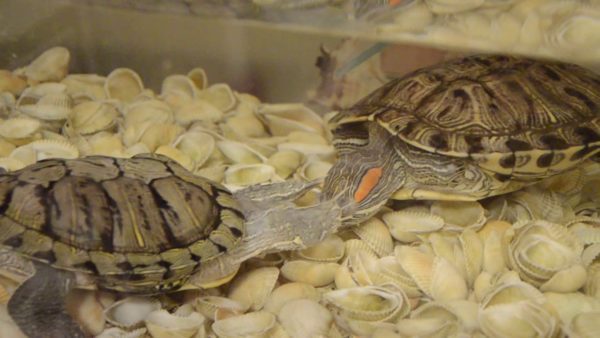
The mating games of the red-eared turtles are manifested by the active courtship of the male for the female he likes. The boy swims in front of the girl with his tail forward and gently tickles the cheeks of the chosen one with the long claws of his front paws. On land, males can approach females and hit the back of the female with their shell. With the simultaneous maintenance of several heterosexual red-eared turtles, males can arrange bloody battles for the right to court a female. In this case, it is recommended to leave a group of several girls and one boy.
Video: marriage games
It is almost impossible to find out that a red-eared turtle is pregnant, but you can suspect a successful conception in a female if you can notice the mating games and the process of intercourse of reptiles. Mating of red-eared turtles takes place in the water and lasts from 5 to 15 minutes, during sexual intercourse, the male tightly hugs the female from behind. Sperm can remain active in the female genital tract for up to 2 years. One sexual intercourse is enough for a female for 4-5 layings.
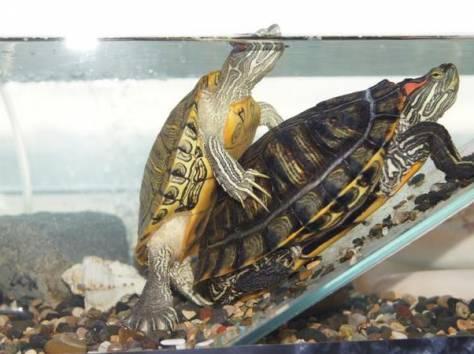
You can also understand that a red-eared turtle is pregnant by the characteristic behavior of the expectant mother. When a reptile carries eggs in itself, it has a change in appetite: from its increase to the complete rejection of food closer to the date of birth. Immediately before laying eggs, the water turtle becomes restless, begins to dig the ground, circles on land in search of a good place for its nest.
The most accurate confirmation of a reptile’s pregnancy is an X-ray examination, with which you can reliably verify the presence of eggs in the female’s genitals.
The pregnancy of the red-eared turtle lasts an average of 60 days and ends with the laying of eggs. It is recommended that the future mother be separated from the male after mating in order to avoid harming the health of the female and her future cubs. During pregnancy, turtles need to be fed a variety of foods, the bulk of the diet should be animal foods rich in calcium.
Video: mating
How red-eared turtles lay their eggs
In their natural habitat, pregnant female red-eared turtles come out onto land to lay their eggs in the warm sand. The turtle is looking for a suitable place for its nest, the reptile can start digging sand several times and throw the dug hole. The work of building a future home for eggs can last from several minutes to three hours.
Pregnant red-eared turtles are encouraged to create the same conditions as their wild relatives. To do this, on the shore of the aquarium, it is necessary to install any plastic container 30 * 30 cm in size, covered with sand 10-15 cm in height. Red-eared turtle eggs laid directly in water have minimal chances of maintaining the viability of the embryos, therefore, if pregnancy is suspected, turtles should be immediately prepared for their laying.
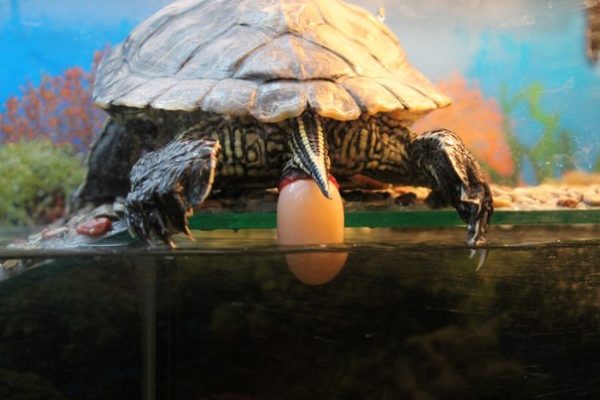
Toward the end of pregnancy, the female intensively digs the sand offered to her. The female digs the nest with her hind legs, gradually moving in a circle to form an even rounded entrance. To maintain ideal humidity, the female wets the sand with liquid from the cloacal ducts during the construction of the nest. After much effort, a deep hole is formed in the sand with a perfectly even entrance, expanding towards the bottom. Having finished with the construction of the nest, the female red-eared turtle lies on the abdomen and lowers its hind legs into the dug hole.
Laying lasts from 5 to 20 minutes, the red-eared turtle lays one egg at a time, after which there is a short respite. After the release of each egg, the reptile lowers its hind legs into the nest and corrects the position of the eggs. At home, a female can lay an average of 10-15 eggs, although their number can vary from 6 to 22. Red-eared turtle eggs look like white round balls with a diameter of 3-4 cm. They have a very fragile leathery shell.
Having finished laying, the reptile carefully digs in a hole with eggs with its hind limbs, wetting it abundantly with urine. The animal circles over the nest for 20-30 minutes, sniffs it and rams it with its abdomen. After laying eggs, the reptile safely forgets about its nest. After mating, the female can make 3-4 clutches, so you should not plant her with the male until autumn. After laying eggs, it is advisable to feed the animal intensively for 2-3 weeks to restore female health.
Video: laying eggs in the sand
What to do if the red-eared turtle laid an egg
Male reptiles cannot carry and lay eggs, but a female red-eared turtle can lay an egg without a male. This physiological feature is also inherent in some birds.
Unfertilized or fatty eggs of red-eared turtles should not be transferred to an incubator, they do not contain embryos of future turtles. If a recently acquired female laid eggs, then they can be fertilized.
If the red-eared turtle has laid eggs, a number of measures must be taken to successfully obtain turtle offspring.
Purchase or build an incubator
The incubation temperature of turtle eggs is 26-32C, below and above these limits, reptile embryos die. A homemade incubator can be built from a glass jar of sand by installing a heat source and a thermometer in it.
Carefully transfer the eggs to the incubator
If the turtle has laid eggs in the aquarium, then they must be pulled out of the water within an hour, otherwise the embryos will suffocate without air. From a nest built in sand or from water, eggs must be removed without changing their original position. To do this, you can carefully mark with a pencil on the top side of the egg. Turning the embryo over can cause its instantaneous death.

Incubate eggs
The maturation of the embryos lasts from 2 to 5 months. When incubated at 26-28C, males are formed in the eggs, at an average temperature of 30-32C, females hatch. Average temperatures are not of fundamental importance for the formation of the floor. Before laying eggs, it is advisable to enlighten them on an ovoscope for the presence of embryos in them. Fertilized eggs look lighter in comparison with fatty ones; when they are translucent, a dark spot of the embryo is detected. If on the first day it was not possible to identify the embryo of a turtle, it is recommended to carefully conduct an examination after a week. Instead of an ovoscope, you can use a flashlight or a regular lamp. During the incubation of future turtles, it is necessary to observe the temperature and humidity in the incubator. If within 2-3 months the reptiles do not hatch, it is necessary to enlighten the eggs again. Embryos could die due to violation of maturation conditions.
Watching the birth of baby turtles
Most often, the egg maturation period is 103 days, the decrease or lengthening of this period mainly depends on the incubation temperature. The turtles cut the shell from the inside and remain in the egg for 1-3 days. It is highly recommended not to extract them yourself. You can help make an incision for turtles that are unable to make an incision of the required size. Also need help, babies, forming a crack in the shell from the side of the sand or the place of contact with another egg. After 5 days, young turtles can be taught to swim, after another 2-3 days it is recommended to treat the animals with the first food.
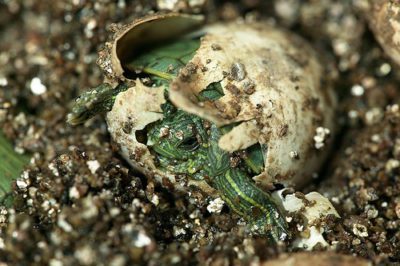
At home, red-eared turtles very rarely become pregnant and lay eggs. But with a successful selection of a pair, the creation of optimal conditions for keeping and proper incubation of eggs, reptile lovers, even in captivity, manage to get a pretty, nimble turtle offspring.
Pregnancy and egg laying in red-eared turtles
3.1 (61.76%) 34 votes



